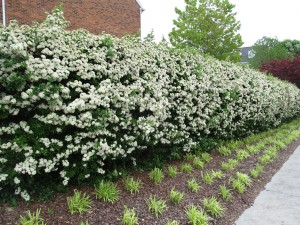White clusters of foul smelling flowers cover the shrub in the spring. Fragrance is not detected from a few feet away. Fruit color depends on the cultivar planted. Firethorn prefers full to partial sunlight (6 hours minimum) and a well-drained average soil. Fertilize in late winter, but do not overfeed. Firethorn is susceptible to bacterial fireblight and scab leaf spot, but disease resistant cultivars are available.
Firethorn creates an effective 8-10 feet barrier or hedge. Sharp ½ – ¾ inch long thorns keep people and pets behind the sharp barrier and unwanted guests on the outside. The short stiff spines are mostly hidden among the foliage.
Firethorn tolerates close clipping and is easily pruned into an espalier against a wall or fence. You should wear leather or heavy canvas gloves to protect your hands during pruning.
Firethorn performs almost evergreen in the Southern Appalachian region (USDA zones 6 and 7), some years defoliating in mid to late winter. The leaves drop pale yellow, rarely catching your eye.
Here are 5 new hybrid cultivars are scab and fire blight resistant:
‘Apache’ grows to 5 feet high and 6 feet wide and forms large, bright red berries that last well into winter.
‘Fiery Cascade’ grows to 8 feet tall and 9 feet wide, and bears orange berries in the fall that turn red in winter.
‘Mohave’ grows to 12 feet tall and wide and develops many big orange-red berries which last well into winter.
‘Rutgers’ bears orange-red fruits on a low spreading 3 feet x 9 feet shrub. It demonstrates better winter hardiness than ‘Mohave’ and ‘Navaho’, writes Dr. Michael Dirr in the Manual of Woody Plants (6th ed.).
‘Teton’ has a tall upright growth habit (12 feet high and 4 feet wide) and is very cold hardy. Berries turn golden yellow in the fall.


 Posted in
Posted in 
